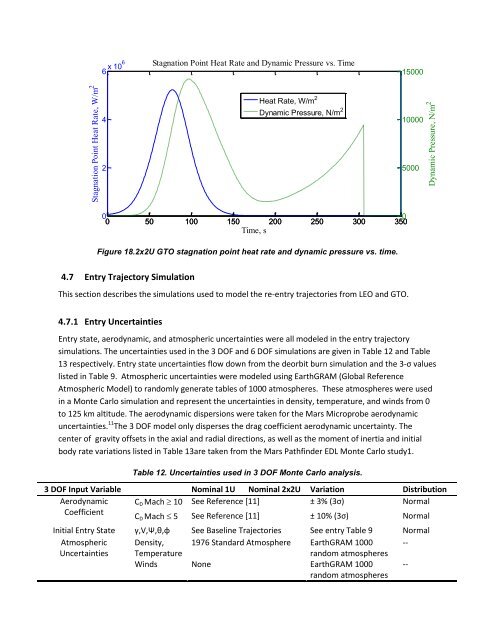SPORE Mission Design - Georgia Tech SSDL - Georgia Institute of ...
SPORE Mission Design - Georgia Tech SSDL - Georgia Institute of ...
SPORE Mission Design - Georgia Tech SSDL - Georgia Institute of ...
Create successful ePaper yourself
Turn your PDF publications into a flip-book with our unique Google optimized e-Paper software.
6 x 106<br />
Stagnation Point Heat Rate and Dynamic Pressure vs. Time<br />
15000<br />
Stagnation Point Heat Rate, W/m 2<br />
4<br />
Heat Rate, W/m 2<br />
Dynamic Pressure, N/m 2<br />
10000<br />
Dynamic Pressure, N/m 2<br />
2<br />
0<br />
0 50 100 150 200 250 300 350<br />
Time, s<br />
Figure 18.2x2U GTO stagnation point heat rate and dynamic pressure vs. time.<br />
0 50 100 150 200 250 300 350 0 5000<br />
4.7 Entry Trajectory Simulation<br />
This section describes the simulations used to model the re-entry trajectories from LEO and GTO.<br />
4.7.1 Entry Uncertainties<br />
Entry state, aerodynamic, and atmospheric uncertainties were all modeled in the entry trajectory<br />
simulations. The uncertainties used in the 3 DOF and 6 DOF simulations are given in Table 12 and Table<br />
13 respectively. Entry state uncertainties flow down from the deorbit burn simulation and the 3-σ values<br />
listed in Table 9. Atmospheric uncertainties were modeled using EarthGRAM (Global Reference<br />
Atmospheric Model) to randomly generate tables <strong>of</strong> 1000 atmospheres. These atmospheres were used<br />
in a Monte Carlo simulation and represent the uncertainties in density, temperature, and winds from 0<br />
to 125 km altitude. The aerodynamic dispersions were taken for the Mars Microprobe aerodynamic<br />
uncertainties. 11 The 3 DOF model only disperses the drag coefficient aerodynamic uncertainty. The<br />
center <strong>of</strong> gravity <strong>of</strong>fsets in the axial and radial directions, as well as the moment <strong>of</strong> inertia and initial<br />
body rate variations listed in Table 13are taken from the Mars Pathfinder EDL Monte Carlo study1.<br />
Table 12. Uncertainties used in 3 DOF Monte Carlo analysis.<br />
3 DOF Input Variable Nominal 1U Nominal 2x2U Variation Distribution<br />
Aerodynamic C D Mach 10 See Reference [11] ± 3% (3σ) Normal<br />
Coefficient<br />
C D Mach 5 See Reference [11] ± 10% (3σ) Normal<br />
Initial Entry State γ,V,Ψ,θ,φ See Baseline Trajectories See entry Table 9 Normal<br />
Atmospheric Density, 1976 Standard Atmosphere EarthGRAM 1000 --<br />
Uncertainties Temperature<br />
random atmospheres<br />
Winds None EarthGRAM 1000<br />
random atmospheres<br />
--
















